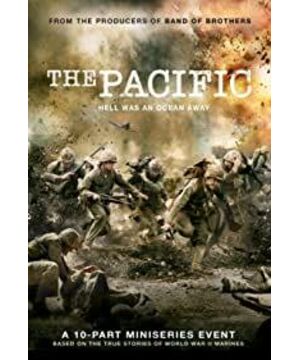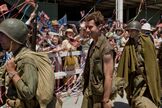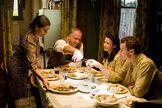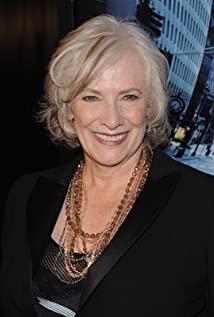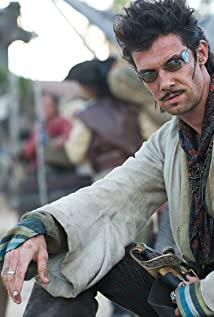The Pacific is drawing to a close. The ninth episode of the attack on Okinawa, and the tenth episode is about soldiers returning home and living a happy life. So here is a brief summary. Because Pacific is a big production, I also compare it with brothers who are also big productions. To be honest, Pacific Ocean and Brother Company have their own merits, but I still prefer Brother Company. Every battle in the Brotherhood is different. Example: First, the airborne scene in Normandy was grand, and then Winters led the squad with his bare hands to attack a German squad in the night, attacked the German artillery position in the morning, and then attacked the German small town for street fighting, followed by field defense, and added the virtues. The two armies battle against each other. Although the subsequent market garden operation was also a street battle, it ended in the defeat of the US army, and there were tank battles in the street battle. In the Ardennes Forest battle, the scene of the jungle snow battle was depicted. There were two relatively large battles. One was the German bombardment of the U.S. forces and the other was the U.S. counterattack. The last battle was when the U.S. Army sneaked into the German position and grabbed the "tongue." It can be said that the battle scenes of the Brothers Company will never make the audience feel repetitive. However, the first four episodes of the battle in the Pacific are all night defensive battles, which makes people feel nothing new. But the later episodes were quite excellent. The Peleliu landing and Iwo Jima landing battles did not have the same feeling of repetition, and the sea, land and air battles were integrated, and the momentum was magnificent. The attack on Peleliu Airport and the Peleliu Mountains were also very brilliant. The details, music, character depiction, and background are equally outstanding. Both are worthy of being five-star masterpieces. I didn’t read the fifth episode carefully, so I didn’t write it well. The sixth episode must be well written. In this episode of the Marine Corps going through the airport, we found that the number of M1 carbines, Thomson submachine guns and M1 Garands is roughly equal (see the appearance rate of M1 Garands in the Brothers Company is much higher than other guns). The following is my personal analysis: Thomson submachine guns are used by non-commissioned officers and officers, and M1 carbines are not suitable for soldiers equipped with M1 Garland. For example, recruit Eugene is a mortar group, so use carbines. There are also machine gunners and signal soldiers, all with carbine. The Marine Corps has its own military rank and is not under the jurisdiction of the Army, resulting in a large number of non-commissioned officers and officers. Look at the Navy, you can always be a lieutenant officer. In summary, the reason may be the high appearance rate of M1 carbine and Thomson submachine gun. I think this episode is better than the fifth episode. At the beginning, the scene of soldiers taking turns drinking water reminded me of a classic text, "An Apple". The soldiers began to charge, and the Japanese army fired all artillery. The scene was magnificent. Finally, they saw the Type 99 light machine gun and the Type 92 heavy machine gun. The U.S. Army suffered heavy casualties. A signal soldier vomited blood while requesting support. I couldn't help but move. Finally, under the cover of the aircraft, the artillery fire in the bunker was suppressed, and the full use of mortars and bazookas eliminated the machine gunners. Lecky was injured, injured by the shock wave of the shell. If this is a domestic drama, this distance won't even kill the villain, let alone the positive. Even if the cannonball falls beside him, he will not die. Even if the plot requires it, but unfortunately sacrificed, he will stand there to survive and die safely. Once again warned the directors of domestic dramas. Soldiers on the battlefield are shot and will fall. They will be beaten while standing and shouting. Grenade is no better than a rifle. They will surely die if they fall by the side. After the airport was captured, an amphibious personnel carrier arrived. The soldiers asked them to take away the wounded soldiers. Those people did not agree, and finally gave in under threats. What I want to say here is, don't think that after being shot, everyone will be as heavy as Fat Brother and still as light as a swallow. The rifle bullet penetrates a small hole and penetrates a large hole. It's okay if you don't cover it on the stomach. At this time, the internal organs have been destroyed. Imagine a scene where you were hit by a rifle and fell, with your intestines exposed, lying on the muddy ground, while the two sides are still fighting. You vomit blood and the cool breeze blows. On your back spine. . . . (Don't say it, it's cruel) One last detail. Soldiers lined up, the soldier on the left hand held a gun in his right hand, and the soldier on the right hand held a gun in his left hand, guarding both sides of the road. (Served, served in worship) At last it rained heavily, and soldiers wore camouflage raincoats. Our domestic drama (I really hate that iron cannot make steel) "On the Taihang Mountains" The Eighth Route Army marched in single clothes and braved the downpour. In many scenes, in order to show that our army does not take the common people every stitch and thread, and does not disturb the people, let the troops run down at night. The heavy rain stood in line in front of the fellow. (Even if Rambo stood like this for one night, the next day will not be able to fight.) Although there are scenes like this in old movies, the director added an important prop — a hat or raincoat, and let the soldiers hide under the eaves. The current TV series is really a step backwards. . . The fifth episode is the beach landing battle I most look forward to. To be honest, the Pacific War = Medal of Honor Bloody Battle Pacific + Call of Duty 5 + Father's Flag + Save Private Ryan + Wind Whisper Warrior + thin red line collection. Especially in this episode, the war scene is huge, and the sea, land and air are integrated, which makes people too addicted to the eyes. The US Army’s Sherman tank finally appeared, and it defeated Japan’s Type 95 light tank with a single shot. It was really exciting. In the fourth episode, in December 1943, all the Marines changed their outfits. Camouflage replaced the old-fashioned military uniforms. Springfield became the M1 Garand and M1 carbine. The Browning water-cooled heavy machine gun was also replaced with an air-cooled device, M1928. The Thomson submachine gun was replaced with the M1 Thomson submachine gun (the handle of the M1928 Thomson submachine gun is on the top of the receiver, and the handle of the M1 is on the right side of the receiver). The Japanese army still charged with the Yuzaka rifle with a bayonet. There is also a plot to kill prisoners of war. To be precise, they cannot be counted as prisoners of war, because the Japanese army was going to commit suicide with a grenade, but was unable to knock the final blow (due to double insurance). In the end, a Southern 14-style pistol was seized, and countless people were rushing for it (it's not Luger, as for it, they will regret using it when they commit suicide one day). There was also a Marine who strangled a Japanese officer alive (because that Japanese soldier was wearing a watch, and ordinary Japanese soldiers did not have a watch). This episode is a night battle defensive battle again, nothing new. This change is highly respected. Different eras and different identities should wear different clothes. The military uniforms of soldiers in the brother company are quite different during training and combat. Remember to watch the "Sidu Chishui" in the early years. The Red Army entered Guizhou, the Qian Army wore blue uniforms and large caps, and entered Sichuan. The Sichuan Army wore green uniforms and large caps. Zhongzheng sword, soldiers wear German steel helmets. It was officially used, Czech light machine guns (not modified with Bren machine guns), Bergman submachine guns, which were not counted. Finally, the Dian army came to help. They were dressed in blue uniforms and British steel helmets. They were really well served. The most noteworthy thing in this episode is that the protagonist was sent to the rear hospital, watching the blue sky, white clouds, feeling the gentle sea breeze, sitting on the lounge chair under the red and white parasol, looking at the beauty The touching little nurse, that cozy, how can you think that not far from the front is a dense war, like a jungle like hell, the director's comparison here is really classic. May there be no more wars in the world. I have watched the third episode. There are no war scenes, so there are no weapons to talk about. Let’s talk about costumes. Different US military services, different armies, divisions, and even some special regiments have their own armbands. When the Marine Corps rests in Australia, it is natural to be accompanied by a military policeman. The sleeve with MP written on a black background and white letters is the famous American military police. Their emblem is the intersection of two old-fashioned pistols. The Army is two rifles intersecting, the officer is the US, the Marine Corps is an eagle above the earth, and an anchor at the bottom left. (The details are in place). They also have this badge on their hats. The brothers' hats are parachutes. Of course, the officer will add his rank to it. Back to the armband, the American armband is rich and colorful. The Marine Corps in the film is the 1st Marine Division, so the armband has a big one. This reminds me of the armband of Dahong First Division. The brother company belongs to the 101 Mountain Eagle Whistling Division, so the armband is a mountain eagle. (Poor national army in the domestic drama, I have only seen armbands in the Bloody Battle at Taierzhuang, the Qiqi Incident and the Jagged Kunlun Pass). There is another detail. Whether the Marine Corps is in the office or on the parade ground, in addition to the American flag, there is also a red flag (I thought it was the Soviet flag at first glance (just kidding), but later I thought it was not made in China. The drama,) was carefully studied, it turned out to be the Marine Corps flag. (The director buys professional knowledge everywhere). Compared with weapons, clothing is not my strong point, so I write silly and make more comments. the pacific began to show weapons again. The Rexin M50 submachine gun, a side-door weapon, also made its debut. In the second episode, when the Marine Corps soldiers came out, the non-commissioned officer who walked in the front took the Rexin M50 submachine gun. In the early days of the war, the Rexin M50 submachine gun was equipped with a small number of troops. Due to its poor performance, it was gradually replaced by the Thomson submachine gun. Status, the M50 submachine gun was used as a training and police weapon. The M1 Garland also began to debut, but it was only equipped with the Army, the Marine Corps was temporarily unable to use it, and complained that he was using the Springfield rifle of his grandfather. The battle at night was more exciting. When the Japanese army rushed to the trenches, the US army took out the Winchester M12 "trench gun", which is a large-caliber shotgun, which is the most effective in close combat in the trenches. (Sigh with emotion that our domestic dramas were swept with the shell gun at a distance of several hundred meters). A soldier was too Rambo to sweep the Japanese army with a Browning water-cooled heavy machine gun of more than 30 kilograms (I have excluded the weight of the gun holder). You know that the Rambo's Gun M60 is only 20 kilograms. The director has a good grasp of weapons and is quite familiar with the replacement of US military weapons during World War II. In fact, making war films requires high awareness of weapons. Different people, different personalities, and different identities use different weapons. I watched the old movie "Dong Cunrui" in the first two days, and I really sighed and admired the attentiveness of the director and staff. For example: Dong Cunrui and his partners used the famous old sleeve and Hanyang made when they were not in the army, they used the 38 large cover when they joined the army to fight in Japan, and some of them were Sten submachine guns during the War of Liberation. When the national army in American military uniform was caught before the Hua Middle School, the soldier was holding a Springfield rifle (even the firearms in the dragon suit were in line with the identity). Alas, it's really a step backward now. I only watched the first episode, second episode and the trailer. Let’s talk about weapons. The background was from 1941 to 1942. The US military was equipped with the Springfield rifle Browning water-cooled heavy machine gun (not the Maxim machine gun, The loading direction of the two is opposite.) Thomson submachine gun (equipped with a drum) helmet uniform without camouflage. The Japanese army helmet is covered with canvas, and the grenade knocks when committing suicide (Japanese grenade is a double insurance, you must knock it when throwing.) The background of the trailer is the US military weapon M1 rifle from 1944 to 1945, Browning air-cooled heavy machine gun, Thomson Submachine gun (equipped with magazine). The master is the master, so details are noticed. And the American flag has 48 stars, not the current 50 stars. Rifle articles: M1 rifle (assembly for ordinary soldiers), M1 carbine is equipped with signal soldiers and technical soldiers and other units that are not suitable for rifles. The butt is a folding butt, an important symbol of paratroopers. The carbines of ordinary infantry divisions are wooden butts, the kind used by the Marine Corps in the Pacific. The Springfield rifle, the rifle used in the United States during World War I, was also heavily equipped with troops in the early days of World War II. This gun is used by the Marine Corps in the Pacific Ocean. After 1943, it gradually withdrew from the battlefield and was replaced by the semi-automatic M1 rifle. Submachine gun: My favorite Chijia typewriter, Thomson submachine gun, has three versions. Brother Lianzhong is a simplified version of the Thompson submachine gun series and the best version. The handle is located on the side of the receiver. The Pacific Central is the M1928 version. At the beginning of the war in 1942, 50 rounds of ammunition drums were used. The 50 rounds of ammunition drums were often jammed, heavy and too heavy. In 1943, they were changed to 20 or 30 rounds magazines. It's all shown in this play. The M3 submachine gun was only equipped with troops at the end of 1944, and the number was small, so only the troops in the brother company had this weapon, but the appearance rate was not high. Normandy was not equipped with troops during the airborne parachute, and there were no troops on the entire French battlefield until the Dutch market garden operation and The Battle of the Ardennes forest only appeared (I really admire the director's carefulness, the difference in weapons can also be shown in just a few months). Machine guns: Bar light machine guns needless to say, Europe and Asia are equipped on battlefields. The Browning water-cooled heavy machine gun, equipped with a large number of troops at the beginning of the Pacific War, is very similar to the Maxine machine gun, but it is not. Maxine reloaded from the right, and Browning from the left. It goes without saying that the Browning air-cooled machine gun is equipped on the European and Asian battlefields. The German Mauser rifles, MP40, MG42, and stg44 assault rifles are all famous guns. There is a small detail. The brothers and even the troops hang these guns on the wall during training for the troops to recognize. (The director everywhere expresses his knowledge of firearms). The Japanese army hasn’t watched it yet. I only watched the first episode. When the Japanese army committed suicide, the grenade slammed. Enough to make me believe that the following content is more exciting. My weapon knowledge is limited, and it is inevitable that I will miss all of them. If you find more exciting details, please provide a lot, thank you.
View more about The Pacific reviews


